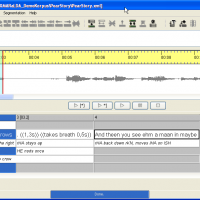Useful Software for Transcriptions
Today’s post will help me leave a mark of what I have been busy with since Monday. After months of readings and recordings (not finished yet), the time is ripe for starting transcriptions and I need to find the software which best suits my needs.
To begin with, these are the main features I am looking for:
- a software for transcriptions which makes the transcribing activity easier (given that it is so time and energy consuming)
- an XML editor (possibly integrated in the above-mentioned software);
- a speech recognition software (possibly)
Despite my being happy with TEI-XML and Xaira, which I used for my Master’s Degree Thesis, I consider this 3 year PhD project as an opportunity to try and learn something new (or at least to test the hypothesis).
So, bearing in mind the pros and the cons of Xaira, I spent some time comparing what follows:
http://www.transana.org/index.htm
I have been told it is extremely useful to transcribe both video and audio files. It also enables you to align text and sound, and the interface is very user-friendly.
I installed it yesterday and it only took me half an hour to understand its main functions and to try and upload 6 episodes in 2 series of the DB I had created. For those of you who haven’t got a clue, a DataBase is, in my case, the DB of didactic recordings. A series may be represented by a specific exam I have recorded and an episode within this series would be the recording of single performances by students.
http://www.fblgroup.it/prodotti.html
This company develops and sells a number of “voice” products such as VoiceTranscribe, Voice Respeaker or VoiceReader. I have been told that VoiceRespeaker, in particular, may be worth trying, since it enables you to synchronize voice and text, obtaining a mixture of WAW and .txt
http://www.dragonvoicerecognition.com/
As far as I know, it is the best voice recognition software available. It works very well if properly trained but I have been told that, given that I deal with community interpreting involving either Italian and English or Italian and French, it may have problems in managing the continuous and quick switching from one language to the other.
http://www.exmaralda.org/en_index.html
I already knew this software, since I considered the possibility of using it also for my Master’s Degree Thesis. But, I quote:
Despite this reader-friendly display, I finally decided to only use TEI (www.tei-c.org), because I was more interested in looking for particular variables rather than in placing them on a timeline. Representing temporal relation with EXMARaLDA would have been time-consuming and I had no particular reason to make this effort. I was interested in signalling starts and ends, but I did not necessarily needed to account for the timing. Taking overlaps, for instance, knowing what was overlapping and where was what counted for me. The when variable does not play such a big role in my analysis, whereas it is basic to all EXMARaLDA transcriptions. The discrepancy between the basic assumptions of EXMARaLDA and my objectives made me turn decidedly to TEI Lite, which in Aston and Cencini (2002) had already proved to be a good encoding standard for interpreting data. (Niemants, 2008: 59)
I must also say that at the time Exmaralda seemed to be very complicated, but things are much easier now. This is what I understand from the website, where one has the opportunity to browse some of the corpora or to contact Dr. Bernd Meyer in order to receive a password (which is what I’ll do).
Just to have an idea of what Exmaralda is, click on the following link, then on one of the communications, and finally on Visualisation : [Partiture]
http://www1.uni-hamburg.de/exmaralda/files/demokorpus/corpus.html#ID0D01F6AF-57F3-858F-BA58-9A0D304D6A72
Is it not wonderful to listen to the audio while you read the transcript?
Moreover, if you are interested in TEI, as I am, you simply have to click on export [TEI] and this is what you will obtain:
http://www1.uni-hamburg.de/exmaralda/files/demokorpus/Royal/export/royal_TEI.xml
At first sight you may think that’s Arabic, but it isn’t. On the contrary! It’s machine-readable language, and also friendly user-readable language (provided that you use a style sheet).
The last lines should be words of gratitude to Gabriele Mack and Claudio Bendazzoli, who helped through my one-week software search, and who kindly provided extremely useful information.
If you have further details on the above-mentioned software, or if you know something different that may meet my desires, feel free to comment this post or to send me an email.
I haven’t made a decision yet, so any piece of advice is happily welcomed ![]()



Mi hanno consigliato anche questo software: http://www.audiotranskription.de/english
E’ molto basic, ma se non avete particolari esigenze potrebbe fare al caso vostro